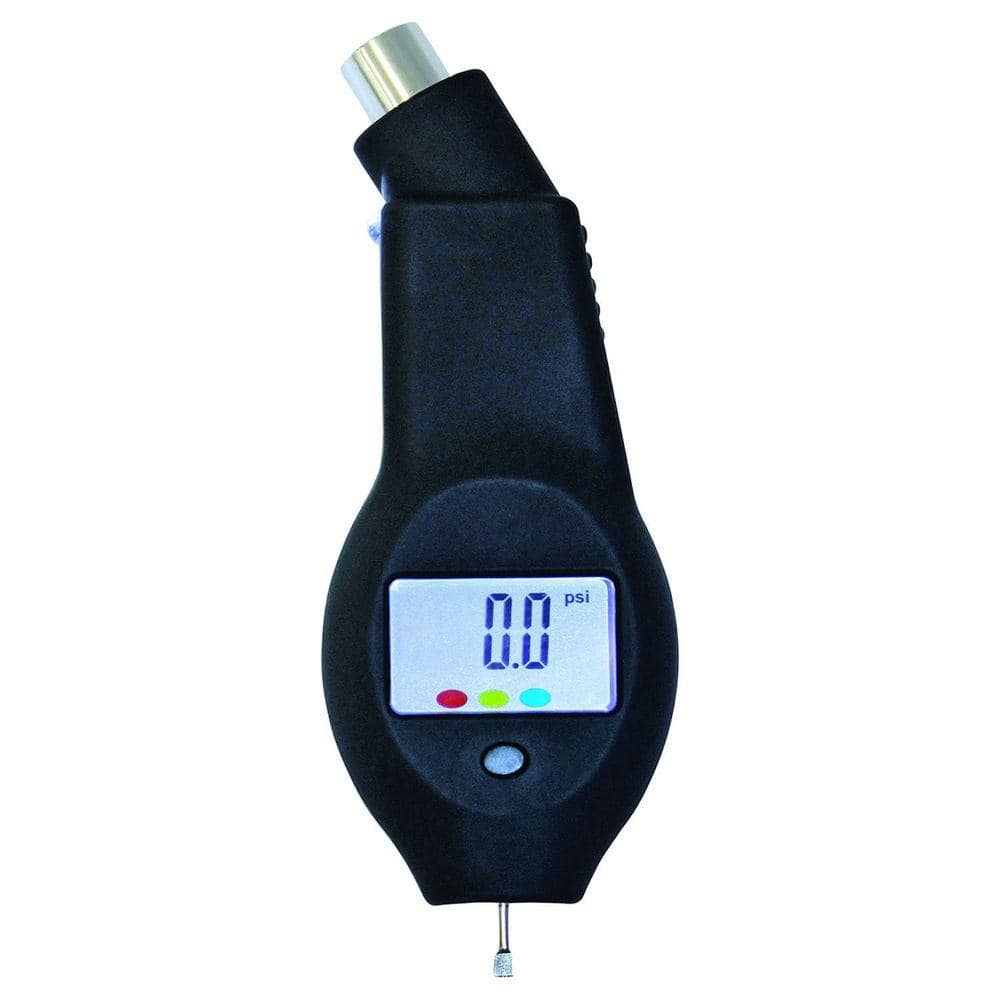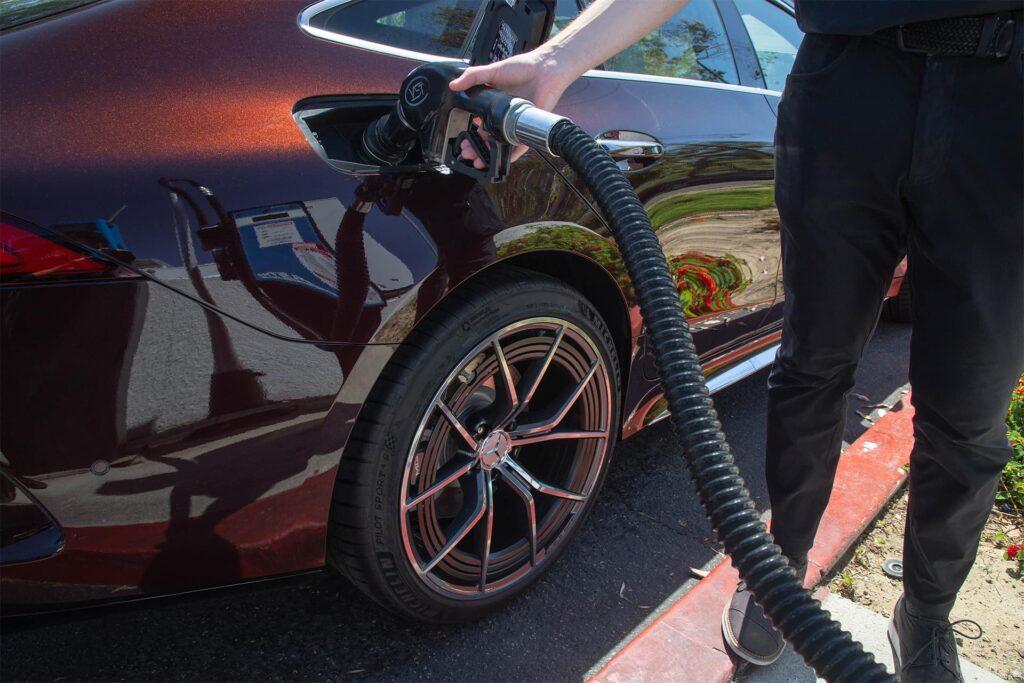It is estimated that for every 1/32” of tire tread depth, fuel efficiency improves by 1%. This means that if your tires are properly inflated and have the recommended amount of tread depth, you could see a significant improvement in your vehicle’s fuel efficiency.
To ensure your tires are properly inflated, check the pressure at least once a month and before long trips.
The proper tire pressure can be found in your owner’s manual or on a sticker inside the driver’s door. Under-inflated tires not only decrease fuel efficiency but can also cause premature wear.
Tire tread depth should be checked regularly as well.
Tires typically have grooves running around their circumference and these grooves help to evacuate water from beneath the tire to improve traction on wet roads. When these grooves become shallow, it’s time to replace the tire. Depending on how much driving you do, tires may need to be replaced every 25,000 miles or so.
making sure your tires are properly inflated and have adequate tread depth is an easy way to improve your vehicle’s fuel efficiency.
If you’re looking to improve your fuel efficiency, one of the best places to start is with your tires. Making sure your tires have the proper tread depth can have a big impact on both your gas mileage and how safe you are on the road. Here are a few tips to help you out:
1. Check your owner’s manual or tire manufacturer’s website to find out what the recommended minimum tread depth is for your vehicle. This will vary depending on the make and model of your car.
2. Inspect your tires regularly to see how much tread they have left.
A simple way to do this is to insert a quarter into the tread groove – if you can see all of George Washington’s head, it’s time for new tires!
3. When it is time for new tires, choose ones that are designed for low rolling resistance. These tires can help improve fuel economy by up to 3%.
4. Keep your tires properly inflated – under-inflated tires can lower gas mileage by up to 0.3% for every 1 PSI drop in pressure below the recommended level.
How Tires Can Save You Money on Gas & Some Shocking Truths About ECO Tires!
What are 5 Ways to Improve a Vehicle’S Fuel Efficiency?
When it comes to improving your vehicle’s fuel efficiency, there are a few key things you can do to make a big difference. Here are 5 ways to get started:
1. Keep Your Tires Inflated
One of the simplest and most effective ways to improve your fuel efficiency is by keeping your tires properly inflated. This helps reduce rolling resistance, which in turn improves gas mileage. You should check your tire pressure at least once a month, and inflate them to the recommended level specified by your car’s manufacturer.
2. Use Cruise Control Whenever Possible
Using cruise control on the highway can help you maintain a consistent speed and avoid wasting gas by accelerating and braking too often. This can be especially helpful when driving long distances.
Just be sure to stay aware of your surroundings and deactivate cruise control when approaching slower traffic or exiting the highway.
3. Avoid Idling Whenever Possible
Idling wastes gas and emits harmful pollutants into the environment, so it’s best to avoid it whenever possible.
If you’re going to be stopped for more than 30 seconds (for example, at a stoplight), shut off your engine until it’s time to move again. This simple measure can save you a significant amount of gas over time.
4.”Drive Smarter” means using techniques that conserve fuel without adversely affecting safety or comfort
5.”Eco-driving” is defined as “a set of driving habits that reduces fuel consumption while respecting other road users.”
Can Tire Tread Affect Gas Mileage?
It is commonly believed that the deeper the tread on a tire, the better grip it will have on the road and the less fuel it will consume. However, studies have shown that there is no significant difference in gas mileage between new tires and those with shallow tread. In fact, Consumer Reports found that smaller, lighter vehicles got slightly better gas mileage with shallower tread than with deeper tread.
While tire tread may not affect gas mileage, other factors such as air pressure and alignment can have a significant impact. Be sure to check your tires regularly and inflate them to the recommended pressure to help maximize fuel efficiency.
What are Two Ways to Improve the Fuel Efficiency of Your Vehicle?
If you’re looking for ways to improve the fuel efficiency of your vehicle, there are a few things you can do. First, make sure your tires are properly inflated. This can help reduce rolling resistance and improve gas mileage by up to 3%.
Secondly, avoid excessive idling. Idling can waste a lot of gas and it’s also bad for your engine. If you’re going to be stopped for more than 30 seconds, it’s better to turn off your engine.
Finally, keep your car well-maintained. Regular tune-ups and oil changes can help improve your car’s gas mileage by up to 4%.
How Can I Improve Gas Mileage on My Tires?
Most people don’t realize that the tires on their car have a huge impact on gas mileage. Tires are essentially big round sponges that grip the road and provide traction. They are also what keep your car from shaking uncontrollably at high speeds.
All of this gripping and holding onto the road takes energy, which ultimately reduces your gas mileage. The good news is that there are ways to improve the gas mileage on your tires.
One way to improve gas mileage on your tires is to make sure they are properly inflated.
Tires that are under-inflated create more rolling resistance, which means the engine has to work harder to move the car forward. This not only wastes gas, but it can also damage your tires. You should check your tire pressure at least once a month and inflate them to the manufacturer’s recommended level.
Another way to improve gas mileage on your tires is by keeping them clean and free of debris. A build-up of dirt, mud or other materials can add weight to your tires and increase rolling resistance. This means that your engine has to work harder again, wasting precious fuel in the process.
To avoid this, simply clean your tires with soap and water on a regular basis or invest in a tire cleaner specifically designed for this purpose.

Credit: www.homedepot.com
How to Improve Fuel Efficiency
Are you looking to improve your vehicle’s fuel efficiency? If so, there are a few things you can do to make this happen. First, be sure to keep your tires inflated to the proper pressure levels.
This will help reduce rolling resistance and improve fuel economy. Second, avoid excessive idling. If you’re going to be stopped for more than a minute or two, it’s better to shut off your engine.
Third, use cruise control whenever possible on the highway – this can help maintain a steady speed and save fuel. Finally, make sure you’re using the right motor oil in your car. A lighter weight oil can actually improve fuel economy by reducing friction within the engine.
By following these tips, you can easily improve your fuel efficiency and save money at the pump!
How to Improve Fuel Efficiency in a Car
Are you looking to improve your car’s fuel efficiency? There are a few things you can do to help make your car more fuel-efficient. Here are a few tips:
1. Keep your tires inflated to the proper pressure. This can help reduce rolling resistance and improve gas mileage by up to 3%.
2. Use the manufacturer’s recommended grade of motor oil.
This can improve gas mileage by up to 2%.
3. Avoid excessive idling. Idling gets 0 miles per gallon!
4. Accelerate gradually and avoid speeding. Sudden acceleration and high speeds can decrease fuel economy by 33% on the highway and 5% on city streets.
5. Use cruise control when possible on the highway.
Cruise control can help maintain a constant speed, which improves gas mileage.
By following these tips, you can help improve your car’s fuel efficiency and save money at the pump!
4/32 Tire Tread
As a driver, you know that it’s important to maintain your car. This includes making sure that your tires have enough tread. The minimum tire tread depth in the U.S. is 4/32 of an inch.
That’s why it’s important to check your tires regularly and replace them when necessary.
There are a few different ways to check your tire tread depth. One is to use a tire tread depth gauge.
You can also do the penny test. Place a penny headfirst into the groove of your tire tread. If you can see all of Lincoln’s head, then your tread depth is less than 4/32 of an inch and it’s time for new tires.
If you keep up with regular maintenance on your car, including checking and replacing your tires as needed, you’ll be able to enjoy many trouble-free miles on the road!
How to Measure Tire Tread
It’s important to regularly check your tire tread depth to ensure safe driving conditions. Here are a few tips on how to measure tire tread:
1. Use a tread depth gauge.
You can purchase one at most auto parts stores.
2. Place the gauge in the deepest part of the tread grooves and press it firmly against the tire.
3. Read the measurement on the gauge and compare it to the minimum tread depth for your tires (usually around 1/16 of an inch).
4. If your tread is below the minimum, it’s time for new tires!
Tire Tread Gauge
Most people know that it is important to check their tire tread regularly. But what many don’t know is how to properly check their tires. This is where a tire tread gauge comes in handy.
A tire tread gauge is a tool that helps you measure the depth of the tread on your tires. It is important to check the tread on your tires often because as the tread wears down, it can affect the performance of your vehicle and make it more difficult to control in certain conditions.
There are a few different types of tire tread gauges available on the market, but they all work in essentially the same way.
To use one, simply insert the gauge into the groove of your tire and read the measurement. Most gauges will have both metric and standard measurements, so be sure to choose one that matches your needs.
As a general rule of thumb, you should replace your tires when the tread depth reaches 4/32nds of an inch (3.2 mm).
However, this may vary depending on driving conditions and other factors, so it’s always best to consult with your local Tire Shop or Mechanic for specific advice.
Conclusion
It is no secret that fuel efficiency has become a top priority for drivers all across the country. In an effort to save money and conserve resources, many of us are looking for ways to improve our gas mileage. One often overlooked way to improve your fuel economy is by maintaining proper tire tread depth.
Tire tread depth plays a crucial role in how your car handles on the road. If your tires are balding, you will likely find yourself slipping and sliding all over the place, which can lead to decreased gas mileage. In addition, bald tires also put you at risk for blowouts and other serious accidents.
To ensure optimal performance from your tires, it is important to check their tread depth regularly. The general rule of thumb is that you should replace your tires when they reach 4/32nds of an inch in tread depth. However, if you live in an area with harsh winters, it is best to replace your tires when they reach 2/32nds of an inch in tread depth.
By following these simple tips, you can help improve your fuel efficiency and keep yourself safe on the road.

